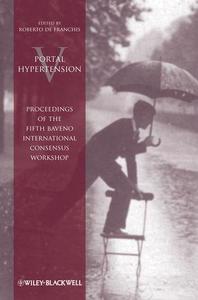
Portal Hypertension V: Proceedings of the Fifth Baveno International Consensus Workshop, Fifth Edition By
2010 | 239 Pages | ISBN: 1444334492 | PDF | 6 MB
Every five years, hepatologists with an interest in portal hypertension (high blood pressure in the portal vein), gather in Baveno, Italy, for the Baveno International Consensus Workshop on Portal Hypertension, attending workshops and examining the latest in clinical data and research on this condition. This book documents the contents of the meeting so that practitioners who could not be present at the conference still have access to the proceedings.Content: Chapter 1 Hepatic Venous Pressure Gradient, Biopsy or Both? (pages 7-17): Guadalupe Garcia?TsaoChapter 2 Elastography in the Non?Invasive Evaluation of the Extent of Fibrosis and in the Diagnosis of Portal Hypertension (pages 18-27): Laurent CasteeraChapter 3 Ultrasound in the Non?Invasive Evaluation of Fibrosis and Portal Hypertension (pages 28-36): Annalisa Berzigotti, Marco Zoli, Concepcion Bru Saumell and Rosa Gilabert SoleChapter 4 Non?Invasive and Minimally Invasive Diagnosis of Varices (pages 37-45): Roberto de FranchisChapter 5 Clinical Epidemiological and Statistical Challenges in Defining, Recording and Analysing Endpoints (pages 46-55): Thorkild Ia Sorensen and Per Kragh AndersenChapter 6 Pre?primary and Primary Prophylaxis: What Has Been Done? (pages 57-65): Carlo Merkel, Manuela Merli and Alessandra Dell'EraChapter 7 Pre?Primary and Primary Prophylaxis: What Should We Do Next? (pages 66-74): Roberto J Groszmann, Cristina Ripoll and Julio VorobioffChapter 8 Failure to Control Bleeding and Failure to Control Rebleeding (pages 75-90): Andrew K Burroughs, Dominique Thabut, Gennaro D'Amico, Flemming Bendtsen, Christophe Bureau, Paul Cales and Angels EscorsellChapter 9 Should Prognostic Variables be Used to Direct Patient Management in the Acute Setting? (pages 91-99): Mario D'Amico and Juan Carlos Garcia?PaganChapter 10 Treatment of Acute Bleeding (pages 101-118): Loren Laine, Shahab Abid, Agustin Albillos, Patrick S Kamath, Jean?Pierre Vinel and Juan Carlos Garcia?PaganChapter 11 Preventing Rebleeding in 2010 (pages 119-131): Norman Grace, Gin?Ho Lo, Frederik Nevens, Tilman Sauerbruch, Peter Hayes, Candid Villanueva and Didier LebrecChapter 12 Stages Classification of Cirrhosis: Where Do We Stand? (pages 132-139): Gennaro D'AmicoChapter 13 Budd?Chiari Syndrome - Hepatic Venous Outflow Tract Obstruction (pages 141-150): Dominique?Charles VallaChapter 14 Extrahepatic Portal Vein Obstruction (EHPVO) (pages 151-164): Shiv Kumar Sarin, Ashish Kumar and Yogesh Kumar ChawlaChapter 15 The Coagulopathy of Chronic Liver Disease. Is the Long and Widely Held Belief Being Dispelled? (pages 165-170): Armando TripodiChapter 16 Anticoagulation Therapy in Cirrhosis with Portal Vein Thrombosis (pages 171-179): Marco SenzoloChapter 17 Variceal Bleeding, Infections and the Hepatorenal Syndrome (pages 180-188): Richard MoreauChapter 18 Portal Hypertension in Children: Current Practice and the Need for Evidence (pages 189-196): Simon C Ling and Benjamin L ShneiderChapter 20 A Look into the Future: New Treatments on the Horizon - Antiviral Therapy (pages 205-210): Diego Rincon, Cristina Ripoll, Maria?Vega Catalina and Rafael BanaresChapter 21 Antifibrotic Drugs (pages 211-217): Massimo PinzaniChapter 22 New Drugs in the Treatment of Portal Hypertension (pages 218-226): Maria Gabriela Delgado, Susana Seijo and Jaime BoschChapter 19 Statins in Portal Hypertension (pages 197-204): Juan G Abraldes, Vincenzo La Mura and Jaime Bosch
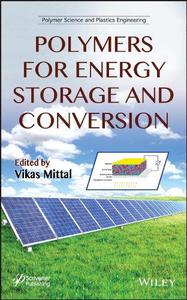
Polymers for Energy Storage and Conversion By
2013 | 265 Pages | ISBN: 1118344545 | PDF | 10 MB
Polymers are increasingly finding applications in the areas of energy storage and conversion. A number of recent advances in the polymer molecular structure control thereby tuning of the polymer properties have led to these applications. This book assimilates these advances in the form of a comprehensive text which includes the synthesis and properties of a large number of polymer systems for applications in the areas of lithium batteries, photovoltaics, solar cells, etc.Polymers for Energy Storage and Conversion describes:PVAc-based polymer blend electrolytes for lithium batteriesThe structure and properties of polymer hydrogel with respect to its applications for low to intermediate temperature polymer electrolyte-based fuel cellsLithium polymer batteries based on ionic liquidsConjugated polymer-inorganic semiconductor compositesThe concept of the solar cell with the organic multiple quantum dots (MQDs)The solvent effects in polymer based organic photovoltaic devicesThe properties of the polymers which factor into their use for solar power both for niche applications as well as for large scale harvestingThe use of macroporous organic polymers as materials for energy gas storage.Content: Chapter 1 High Performance Polymer Hydrogel Based Materials for Fuel Cells (pages 1-25): Yogeshwar Sahai and Jia MaChapter 2 PVAc Based Polymer Blend Electrolytes for Lithium Batteries (pages 27-51): M. Ulaganathan, R. Nithya and S. RajendranChapter 3 Lithium Polymer Batteries Based on Ionic Liquids (pages 53-101): S. Passerini, M. Montanino and G.B. AppetecchiChapter 4 Organic Quantum Dots Grown by Molecular Layer Deposition for Photovoltaics (pages 103-136): Tetsuzo YoshimuraChapter 5 Solvent Effects in Polymer Based Organic Photovoltaics (pages 137-161): Matthias A. Ruderer and Peter Muller?BuschbaumChapter 6 Polymer?Inorganic Hybrid Solar Cells (pages 163-197): Ashish Dubey and Qiquan QiaoChapter 7 Semiconducting Polymer?based Bulk Heterojunction Solar Cells (pages 199-214): Matthew Schuette White and Niyazi Serdar SariciftciChapter 8 Energy Gas Storage in Porous Polymers (pages 215-248): Joel Fawaz, Kean Wang and Ali Almansoori
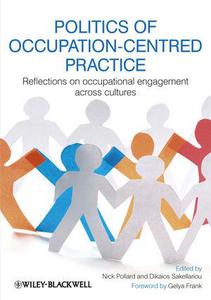
Politics of Occupation-Centred Practice By
2012 | 254 Pages | ISBN: 1444336983 | PDF | 2 MB
Politics of Occupation-Centred Practice addresses the cultural aspects of occupational identity and draws out the implications for practice, moving beyond the clinical environment to include the occupational therapist's work in the wider community. It explores the development of individual occupational narratives, community traditions and their roots in everyday experiences, offering a range of examples from distinctive populations to demonstrate approaches to forming sustainable occupational engagements. Chapters span such key areas as 'Experiences of Disaster', 'Social Inclusion', 'Disability and Participation', and 'Sexuality, Disability Cultures and Occupation'. This cutting edge text, coordinated by two distinguished researchers and educators in the global field of occupational therapy and science, is designed to meet the needs of students studying the conceptual foundations of occupational therapy, occupational science, role emerging practice, occupational justice, community development and community based rehabilitation. The book will also be of interest to academics and practitioners exploring new practice contexts created by the drive to address the diversity and inclusion agenda.Content: Chapter 1 Introduction (pages 1-24): Nick Pollard and Dikaios SakellariouChapter 2 The Language of Occupation (pages 25-41): Nick Pollard and Dikaios SakellariouChapter 3 Occupational Literacy (pages 42-50): Nick Pollard and Dikaios SakellariouChapter 4 A Grammar for a Language of Occupation (pages 51-60): Nick Pollard and Dikaios SakellariouChapter 5 Towards a Transformational Grammar of Occupation (pages 61-71): Nick Pollard and Dikaios SakellariouChapter 6 Narratives of Recognition (pages 72-80): Dikaios Sakellariou and Nick PollardChapter 7 Narratives and Truths (pages 81-91): Dikaios Sakellariou and Nick PollardChapter 8 Occupation in a Greek Town: Flowing, Emergent, Flexible across Time and Space (pages 92-105): Sarah Kantartzis, Matthew Molineux and Sally FosterChapter 9 Indigenous Ainu Occupational Identities and the Natural Environment in Hokkaido (pages 106-127): Mami AoyamaChapter 10 People with Disabilities and Participation: Experiences and Challenges of an Occupational Therapy Practice in the City of Sao Paulo, Brazil (pages 128-145): Sandra Maria Galheigo, Fatima Correa Oliver, Taisa Gomes Ferreira and Marta AokiChapter 11 Communities of Writing (pages 146-161): Nick PollardChapter 12 Disability, Sexuality and Intimacy (pages 162-179): Pamela Block, Russell Shuttleworth, Jacob Pratt, Hope Block and Linda RammlerChapter 13 Model and Human Occupation (pages 180-196): Nick Pollard and Neil CarverChapter 14 Participation, Time, Effort and Speech Disability Justice (pages 197-216): Devva Kasnitz and Pamela BlockChapter 15 A Society Founded on Occupation (pages 217-236): Nick Pollard and Dikaios Sakellariou
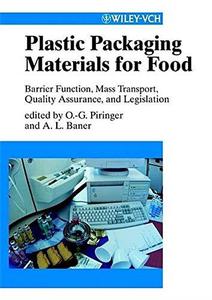
Plastic Packaging Materials for Food: Barrier Function, Mass Transport, Quality Assurance, and Legislation By
2000 | 595 Pages | ISBN: 3527288686 | PDF | 19 MB
Plastics have developed into the most important class of packaging materials. Their relative impermeability for substances from the surroundings has great influence on the shelf life and the quality of the packed goods. At the same time the interaction between the contents and the various components of the packaging plays a decisive role. This particular book is indispensable in the search for the optimal plastic packaging. It facilitates the estimation of the influence on the goods which come from the surroundings and from the packaging. The authors do not restrict themselves only to the description of the phenomena of diffusion or transport in theory, but they show what they mean for practical applications. Food represents the central theme as main area of application for plastic packaging. It can be considered to be the "model substance" and the findings are to be applied to many other products and systems. The main rules and regulations for food packaging of the European Community and the United States are presented in this book. Furthermore the authors emphasize the testing methods for proving the mass transport and the sensory check of the quality of the products. Content: Chapter 1 Preservation of quality through packaging (pages 1-8): Albert L. Baner and Otto PiringerChapter 2 Characteristics of plastic materials (pages 9-45): Johannes Brandsch and Otto PiringerChapter 3 Additives for plastics and their transformation products (pages 47-77): Jan Pospisil and Stanislav NespurekChapter 4 Partition coefficients (pages 79-123): Albert L. BanerChapter 5 Models for diffusion in polymers (pages 125-157): Peter MerceaChapter 6 Prediction of diffusion coefficients in gases, liquids, amorphous solids and plastic materials using an uniform model (pages 159-181): Otto PiringerChapter 7 Transport equations and their solutions (pages 183-219): Otto PiringerChapter 8 Numerical solutions of the diffusion equation (pages 221-238): Titus A. BeuChapter 9 Permeation of gases, water vapor and volatile organic compounds (pages 239-285): Otto PiringerChapter 10 Migration of plastic constituents (pages 287-357): Roland FranzChapter 11 Migration from food packaging: Regulatory considerations for estimating exposure (pages 359-392): Timothy H. BegleyChapter 12 European Community legislation on materials and articles intended to come into contact with food (pages 393-406): Luigi RossiChapter 13 Sensory problems caused by food and packaging interactions (pages 407-426): Otto Piringer and Monika RuterChapter 14 Case study: styrene monomer migration into dairy products in single serve portion packs (pages 427-443): Albert L. BanerChapter 15 Possibilities and limitations of migration modeling (pages 445-468): Johannes Brandsch, Peter Mercea and Otto Piringer
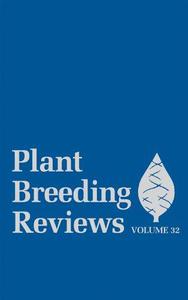
Plant Breeding Reviews: Raspberry Breeding and Genetics, Volume 32 By
2009 | 392 Pages | ISBN: 0470386746 | PDF | 15 MB
Plant Breeding Reviews presents state-of-the-art reviews on plant breeding and genetics covering horticultural, agronomic and forestry crops, incorporating both traditional and molecular methods. The contributions are authored by world authorities, anonymously reviewed, and edited by Professor Jules Janick of Purdue University, USA. The series is an indispensible resource for crop breeders, plant scientists, and teachers involved in crop improvement and genetic resources. Initiated in 1983, Plant Breeding Reviews is published in the form of one or two volumes per year. Recently published articles include: Epigenetics and Plant Breeding (v30) Enhancing Crop Gene Pools with Beneficial Traits Using Wild Relatives (v30) Coffee Germplasm Resources, Genomics and Breeding (v30) Molecular Genetics and Breeding for Fatty Acid Manipulation in Soybean (v30) Breeding Southern Highbush Blueberries (v30) Development of Fire Blight Resistance by Recombinant DNA Technology (v29) Content: Chapter 1 Dedication: Derek Jennings and Hugh A. Daubeny Berry Breeders Extraordinaire (pages 1-37): Kim E. Hummer, Rex Brennan, S. Nikki Jennings, Brian Williamson and Harvey K. HallChapter 2 Raspberry Breeding and Genetics (pages 39-353): Harvey K. Hall, Kim E. Hummer, Andrew R. Jamieson, S. Nikki Jennings and Courtney A. Weber
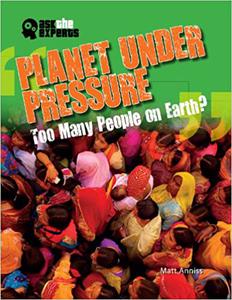
Matt Anniss, "Planet Under Pressure: Too Many People on Earth?"
English | 2013 | ISBN: 1433986434 | PDF | pages: 50 | 12.1 mb
The population of Earth has exploded over the last 100 years. The planet now supports about 7 billion people, and this overwhelming number has many repercussions. Alternative energy resources and the costs of healthcare have become urgent matters. Questions about how to feed, clothe, and house a growing population demand answers. Poverty and overpopulation are no longer just problems for third-world countries but issues that need to be addressed in our own communities. Readers are presented with the many topics surrounding world population and the questions that experts are asking. Also highlighted are suggested solutions, some as radical as setting up colonies on other planets.
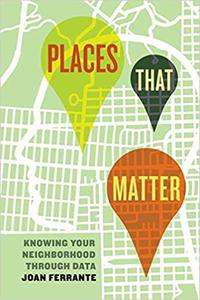
Dr. Joan Ferrante, "Places That Matter: Knowing Your Neighborhood through Data"
English | ISBN: 0520292359 | 2018 | 232 pages | EPUB | 6 MB
Places that Matter asks the reader to identify a place that matters in their life-their home, a place of worship, a park, or some other site that acts as an emotional and physical anchor and connects them to a neighborhood. Then readers are asked: In what ways do I currently support-or fail to support-that neighborhood? Should support be increased? If so, in what ways?

Gillian McClelland, Diana Hadden, "Pioneering Women: Riddel Hall and Queen's University Belfast"
English | 2005 | ISBN: 1903688574 | EPUB | pages: 214 | 33.8 mb
Few topics have produced more heroines than the struggle of women for their right to education. Foremost amongst the pioneers of third-level education for women in the north of Ireland were Eliza and Isabella Riddel. Never themselves having had the opportunity of university education, in 1913 they founded Riddel Hall as a residence for women students. Ruth Duffin, the hall's formidable first warden, had very strong ideas about citizenship, culture, and physical exercise that proved to be visionary in every sense. The personal chronicle she kept, recording how she realized her ambition to bring culture and self-empowerment to sometimes reluctant female students, is one of the fascinating features of this book. The reports of two of Ruth's successors as wardens, and the reminiscences of former students, outline how the challenges posed by the new educational order in the post-World War Two era and into the swinging sixties were met. Later events and a series of problems leading to the eventual closure of what had remained a haven of sanity in a quickly-changing educational world, are recounted with the help of the recollections of former students, in a sensitive and affectionate narrative. In its last phase, the Hall was occupied by the Arts Council of Northern Ireland. This short but intriguing interlude is recounted by Marcus Patton. And, of course, no one is better placed than Patton to describe the physical attributes of a building that holds warm memories for thousands of students and which played not only a formative role in their young lives but also provided a crucial facility for women's third-level education in Northern Ireland.

Phaselock Techniques, Third Edition By Floyd M. Gardner(auth.)
2005 | 444 Pages | ISBN: 0471430633 | PDF | 4 MB
A greatly revised and expanded account of phaselock technology The Third Edition of this landmark book presents new developments in the field of phaselock loops, some of which have never been published until now. Established concepts are reviewed critically and recommendations are offered for improved formulations. The work reflects the author's own research and many years of hands-on experience with phaselock loops. Reflecting the myriad of phaselock loops that are now found in electronic devices such as televisions, computers, radios, and cell phones, the book offers readers much new material, including: * Revised and expanded coverage of transfer functions * Two chapters on phase noise * Two chapters examining digital phaselock loops * A chapter on charge-pump phaselock loops * Expanded discussion of phase detectors and of oscillators * A chapter on anomalous phaselocking * A chapter on graphical aids, including Bode Descriptions, root locus Descriptions, and Nichols charts As in the previous editions, the focus of the book is on underlying principles, which remain valid despite technological advances. Extensive references guide readers to additional information to help them explore particular topics in greater depth. Phaselock Techniques, Third Edition is intended for practicing engineers, researchers, and graduate students. This critically acclaimed book has been thoroughly updated with new information and expanded for greater depth.Content: Chapter 1 Introduction (pages 1-5): Chapter 2 Transfer Functions of Analog PLLs (pages 6-28): Chapter 3 Graphical Aids (pages 29-64): Chapter 4 Digital PLLs: Transfer Functions and Related Tools (pages 65-96): Chapter 5 Tracking (pages 97-122): Chapter 6 Effects of Additive Noise (pages 123-142): Chapter 7 Effects of Phase Noise (pages 143-182): Chapter 8 Acquisition of Phaselock (pages 183-208): Chapter 9 Oscillators (pages 209-236): Chapter 10 Phase Detectors (pages 237-266): Chapter 11 Loop Filters (pages 267-270): Chapter 12 Charge?Pump Phaselock Loops (pages 271-281): Chapter 13 Digital (Sampled) Phaselock Loops (pages 282-335): Chapter 14 Anomalous Locking (pages 336-356): Chapter 15 PLL Frequency Synthesizers (pages 357-379): Chapter 16 Phaselock Modulators and Demodulators (pages 380-407): Chapter 17 Miscellaneous Applications of Phaselock Loops (pages 408-419):

Pharmacovigilance, Second Edition By
2007 | 679 Pages | ISBN: 0470018038 | PDF | 18 MB
Written by an international team of outstanding editors and contributors, Pharmacovigilance, 2nd Edition is the definitive text on this important subject. The new edition has been completely revised and updated to include the latest theoretical and practical aspects of pharmacovigilance including legal issues, drug regulatory requirements, methods of signal generation, reporting schemes and pharmacovigilance in selected system-organ classes. . The editors and contributors are of excellent standing within the pharmacovigilance community The text provides exemplary coverage of all the relevant issues The definitive book on the subject Content: Chapter 1 Introduction (pages 1-11): Hon. Member ISoP Ronald D. Mann and Elizabeth B. AndrewsChapter 2 Legal Basis - EU (pages 13-23): Nicholas MacFarlane, Paul Brown, Caroline Moore, Claire Taylor, Uwe Froehlich, Tanja Barton, Olivier Banchereau and Paola La LicataChapter 3 Legal Basis - United States (pages 25-34): Jayne P BultenaChapter 4 Ethical Oversight, Consent and Confidentiality (pages 35-49): Donna A. Boswell and Elizabeth B. AndrewsChapter 5 Pharmacovigilance?Related Topics at the Level of the International Conference on Harmonisation (pages 51-62): Priya Bahri and Panos TsintisChapter 6 Periodic Safety Update Reports (pages 63-74): Patrice Verpillat and Mondher ToumiChapter 7 Non?Clinical Safety Evaluation and Adverse Events in Phase I Trials (pages 75-84): Patricia M. Reed, Stuart J. Mair and Stephen FreestoneChapter 8 Mechanisms of Adverse Drug Reactions (pages 85-103): Munir Pirmohamed and Hon MRCP B. Kevin ParkChapter 9 Micturin and Torsades de Pointes (pages 105-108): Richard N. WildChapter 10 Withdrawal of Terodiline: A Tale of Two Toxicities (pages 109-136): Rashmi R. ShahChapter 11 Nomifensine and Haemolytic Anaemia (pages 137-147): Peter D. Stonier and J. Guy EdwardsChapter 12 WHO Programme - Global Monitoring (pages 149-166): I. Ralph Edwards and Cecilia BiriellChapter 13 Medical Dictionary for Regulatory Activities (MedDRA®) (pages 168-183): Elliot BrownChapter 14 Regulatory Pharmacovigilance in the EU (pages 185-198): Priya Bahri, Panos Tsintis and Patrick C. WallerChapter 15 Spontaneous Reporting - UK (pages 199-215): Sarah Davis, Bridget King and June M. RaineChapter 16 Spontaneous Reporting - France (pages 217-226): Nicholas Moore, Carmen Kreft?Jais and Alban DhananiChapter 17 Spontaneous Reporting in Germany (pages 227-235): Ulrich Hagemann and Norbert PaeschkeChapter 18 Spontaneous Reporting - United States (pages 237-247): David J. Graham, Syed R. Ahmad and Toni Piazza?HeppChapter 19 Statistical Methods of Signal Detection (pages 249-255): Stephen EvansChapter 20 Statistical Methods of Evaluating Pharmacovigilance Data (pages 257-264): Bernard BegaudChapter 21 Data Mining in Pharmacovigilance: A View from the Uppsala Monitoring Centre (pages 265-275): I. Ralph Edwards, Marie Lindquist, Andrew Bate and G. Niklas NorenChapter 22 Pharmacovigilance in the Netherlands (pages 277-285): Kees van Grootheest and Eugene van PuijenbroekChapter 23 CIOMS Working Groups and their Contribution to Pharmacovigilance (pages 287-305): Sue Roden and Trevor GibbsChapter 24 PEM in the UK (pages 307-316): Saad A. W. ShakirChapter 25 PEM in New Zealand (pages 317-332): Mira Harrison?Woolrych and David M CoulterChapter 26 MEMO in the United Kingdom (pages 333-340): Douglas Steinke, Josie M. M. Evans and Thomas M MacdonaldChapter 27 The General Practice Research Database: Now and the Future (pages 341-348): John Parkinson, Sarah Davis and Tjeerd van StaaChapter 28 Overview of North American Databases (pages 349-359): Brian L. Strom and Judith L. KinmanChapter 29 Other Databases in Europe for the Analytic Evaluation of Drug Effects (pages 361-373): Miriam C. J. M. SturkenboomChapter 30 Surveillance for Medical Devices - USA (pages 375-385): Thomas P. GrossChapter 31 Pharmacovigilance and Risk Management in Japan (pages 387-394): Kiyoshi Kubota and Hiroko KoyamaChapter 32 Dermatological ADRs (pages 395-405): Laurence Allanore?Valeyrie and Jean?Claude RoujeauChapter 33 Gastrointestinal ADRs (pages 407-418): John R. Wood and Graham A. PipkinChapter 34 Haematological ADRs (pages 419-428): Peter J CareyChapter 35 Hepatic ADRs (pages 429-443): Guruprasad P. Aithal and Christopher P DayChapter 36 Ocular Side Effects of Prescription Medications (pages 445-453): F. W. FraunfelderChapter 37 Drug Safety in Pregnancy (pages 455-466): Christina D. Chambers and Elizabeth B. AndrewsChapter 38 Renal Adverse Drug Reactions (pages 467-474): Gert A VerpootenChapter 39 Anaesthetic Adverse Drug Reactions (pages 475-496): Anita HoldcroftChapter 40 Pharmacovigilance in Pediatrics (pages 497-506): Solomon Iyasu and M Dianne MurphyChapter 41 The Cardiovascular Spectrum of Adverse Drug Reactions (pages 507-514): Judith Hsia, Jinping Mo, Laura Burleson and Annlouise R. AssafChapter 42 Drugs and the Elderly (pages 515-532): Una Martin and Jamie J. ColemanChapter 43 US Activities in Risk Management of Pharmaceutical Products (pages 533-552): Jonca BullChapter 44 Risk Management - a European Regulatory View (pages 553-558): June M. RaineChapter 45 The Efficacy and Safety of Selective Serotonin Reuptake Inhibitors for the Treatment of Depression in Children and Adolescents (pages 559-570): Julie Magno Zito and Daniel J. SaferChapter 46 Pharmacoepidemiology of Hormone Therapy: An Evolving Picture (pages 571-581): Annlouise R. Assaf, Laura E. Burleson and Joann E. MansonChapter 47 NSAIDs - COX?2 Inhibitors - Risks and Benefits (pages 583-602): K. Arnold Chan and S. Christopher JonesChapter 48 Introduction to Pharmionics: The Vagaries in Ambulatory Patients' Adherence to Prescribed Drug Dosing Regimens, and Some of Their Clinical and Economic Consequences (pages 603-618): John Urquhart and Bernard VrijensChapter 49 Teaching and Learning Pharmacovigilance (pages 619-632): Frank MayChapter 50 Fatal Medication Errors and Adverse Drug Reactions - Coroners' Inquests and Other Sources (pages 635-645): R. E. Ferner, S. E. McDowell and A. K. CotterChapter 51 Pharmacogenetics and the Genetic Basis of ADRs (pages 647-666): Penelope K. ManascoChapter 52 Keynote Clinical Lessons from Pharmacovigilance (pages 667-676): David H. Lawson and Keith Beard


